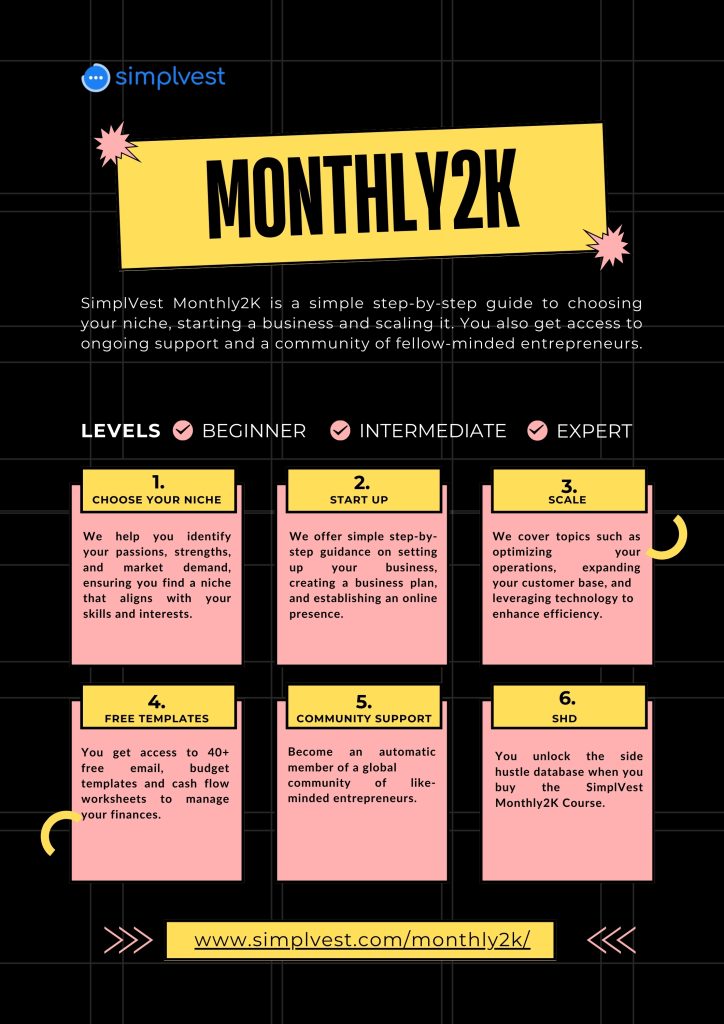Good ideas can come from those light-bulb moments. But they can also come from structured brainstorming as well. Brainstorming methods can be as simple as making lists or as detailed as making a mind map. When done systematically, they can unlock opportunities you never considered. Below, we explore 10 proven methods to brainstorm business ideas, generate innovative business concepts, refine them and identify the most promising opportunities for 2025 and beyond.

1. Analyze Your Personal Spending Habits
Your bank statements reveal potential business opportunities. This method works because you’re already a validated customer for these products or services. This gives you insider knowledge about what consumers actually want.
Review the last three months of your personal spending and identify patterns. Are there recurring subscriptions, frequent purchases, or one-time expenses that stand out? For each significant transaction, ask yourself:
- Could I offer this product or service to others?
- Is there a way to improve upon what’s currently available?
- Are there complementary products or services that could enhance this offering?
For example, if you notice frequent spending on meal delivery services, you might explore launching a niche meal prep business that will cater to specific diets like keto or Mediterranean. If you regularly buy eco-friendly products, perhaps there’s a market for a curated sustainable alternatives subscription box.
The beauty of this approach is that it’s grounded in real consumer behaviour: your own. You understand the pain points, the value proposition and the willingness to pay because you’ve experienced it firsthand.
2. Examine Business Expenses (From Work or Side Projects)
If you have access to business financial records, whether from your job, a family business, or freelance work, study those expenses carefully. Look for:
- Recurring costs (software subscriptions, outsourcing, maintenance)
- Pain points (inefficiencies in vendor services, poor customer support)
- Gaps in the market (no affordable alternatives, missing features)
For instance, if a company spends heavily on outsourced graphic design but struggles with communication and turnaround times, you might consider launching a streamlined design agency with transparent processes and faster delivery. If businesses in your industry struggle with a particular software tool, you could develop a better solution or offer consulting services to optimize their current systems.
3. Ask “What If?”
Another way to brainstorm business ideas is to ask what if? This creative exercise pushes you to think beyond conventional boundaries and explore unconventional angles that could disrupt existing markets. True creativity and ingenuity occur when you don’t try to control the process, so embrace the absurd and unexpected.
Start with a skill, interest, or industry and ask provocative “What if?” questions:
- What if fitness trainers could conduct personalized sessions in virtual reality?
- What if pet owners could rent out their dogs for social media photoshoots?
- What if there was a subscription service for rare book collectors with authentication services?
- What if elderly people could share their life stories through AI-powered interactive documentaries?
The goal isn’t to find immediately viable ideas but to stretch your thinking. Often, the most innovative businesses come from seemingly impossible combinations that, upon further reflection, make perfect sense.

4. Problem-Solution Mapping
Every successful business solves a problem and the bigger the problem, the bigger the opportunity. This systematic approach is another way to brainstorm business ideas. It involves identifying genuine pain points and working backwards to find solutions.
To map problems, start by listing everyday frustrations, either in your personal life or within specific industries and then brainstorm multiple solutions for each:
Problem: Finding reliable local service providers (plumbers, electricians, contractors).
Solutions: A verified, on-demand home services app with real-time reviews, insurance coverage, and guaranteed response times.
Problem: Office workers struggling with unhealthy snack options and expensive cafeteria food.
Solutions: A healthy vending machine service for corporate spaces, or a meal-sharing platform where employees can order homemade lunches from colleagues.
Problem: Small business owners spending too much time on bookkeeping.
Solutions: An AI-powered accounting assistant that categorizes expenses automatically and provides real-time financial insights.
By focusing on real pain points that affect large numbers of people, you increase the chances of your business idea gaining traction and generating sustainable revenue.
5. Trend Surfing
Staying ahead of emerging trends can lead to lucrative first-mover advantages. Research shows that businesses aligned with growing trends have significantly higher success rates than those fighting against market currents.
Research and educate yourself in emerging developments in:
- Technology: AI automation, blockchain applications, virtual reality experiences
- Consumer behaviour: Sustainability focus, remote work lifestyle, personalized health and wellness
- Cultural shifts: Mental health awareness, digital nomadism, aging population needs
For instance, the rise of remote work has fueled demand for co-living spaces, digital nomad visas, productivity tools for distributed teams and virtual team-building services. The growing focus on mental health has created opportunities for meditation apps, workplace wellness programs, and therapy-matching platforms.
According to Shopify’s research, businesses that align with cultural and technological trends are more likely to achieve rapid growth and attract investment.
6. The Combination Method
Innovation often comes from merging two unrelated ideas or industries. Think of successful hybrids like Netflix (DVD rentals + subscription model), Uber (ride-sharing + mobile payments), or Airbnb (hospitality + peer-to-peer sharing).
Try combining unexpected concepts:
- Subscription box + Language learning = Monthly cultural immersion kits with authentic foods, music, and learning materials from different countries
- Fitness + Gamification = An app that turns workouts into RPG quests with character progression and social challenges
- Pet care + Technology = Smart pet monitoring systems that alert owners to health issues and automatically schedule vet appointments
To brainstorm business ideas in this way means out-of-the-box thinking that can lead to truly unique business models that are difficult for competitors to replicate.
7. Ask Your Network for Insights
Your friends, family and professional contacts can provide valuable feedback and uncover niche demands you hadn’t considered. Discussing and refining ideas while considering different perspectives and constructive feedback is another crucial way to brainstorm business ideas.
You should conduct informal interviews and ask targeted questions:
- “What’s a product or service you wish existed but can’t find anywhere?”
- “What’s the most frustrating part of your job/hobby that no one has solved yet?”
- “If you had unlimited budget, what would you hire someone to do for you?”
You might discover opportunities like a platform for freelance musicians to find gigs, a marketplace for handmade home decor with virtual room visualization, or a service that helps busy parents plan and execute children’s birthday parties.
8. Reverse Brainstorming
This unconventional technique involves flipping the script: Instead of asking “How can we solve X?” ask “How could we make X worse?” Then reverse those insights to find improvement opportunities.
For example: Question: How could we make grocery shopping more frustrating?
Answers: Long checkout lines, out-of-stock items, confusing store layouts, expired products, unhelpful staff.
Reversed solutions: A cashier-less store with mobile payment, AI-powered stock management with real-time alerts, optimized store navigation apps, freshness guarantee programs, and knowledgeable personal shopping assistants.
This approach helps identify overlooked inefficiencies that could be turned into competitive advantages.

9. Study Competitors, then Differentiate
Instead of reinventing the wheel, analyze existing businesses in your field of interest and find ways to do it better. Research from Harvard Business Review suggests that studying successful business models and identifying improvement opportunities is more effective than starting from scratch.
Look out for:
- What they do well (and how you can match or exceed it)
- What they lack (features, customer service, pricing options)
- Underserved market segments (demographics, geographic areas, specific needs)
For example, if local bakeries only offer traditional pastries, you could introduce a gluten-free, keto, or vegan bakery with online ordering and delivery. If existing SaaS tools have poor customer support, you could build a similar product with exceptional service as your primary differentiator.
10. Leverage Your Unused Skills or Hobbies
Many successful businesses stem from personal passions and existing expertise. This approach has several advantages: lower startup costs (since you’re already skilled), authentic marketing (you genuinely understand the customer), and higher motivation during challenging times.
Ask yourself these questions:
- What am I naturally good at that others might pay for?
- What hobby or interest could I monetize without losing my passion for it?
- What skills do I have that my current employer doesn’t fully utilize?
A photographer might start selling Lightroom presets and photography courses, a fitness enthusiast could create personalized workout plans and nutrition coaching, and a writer could launch a copywriting agency specializing in their industry expertise.
The key is finding the intersection between your skills, market demand and personal interest, what some call your “zone of genius.”
From Idea to Action: Validation is Key
Keep your brainstorming sessions brief, about 10 minutes long to start, but remember that brainstorming is just the first step. The most critical phase is validation. Before committing significant time or money, test your ideas through:
- Market research: Use Google Trends, conduct surveys, analyze competitors
- Minimum viable product (MVP) testing: Create a simple landing page to gauge interest
- Pilot sales: Sell small batches or offer beta services to test demand
- Customer interviews: Talk to potential customers about their needs and willingness to pay
According to MasterClass, the goal is to end up with a large number of ideas initially, then systematically narrow them down to the most viable opportunities.

Conclusion
The best business ideas solve real problems, align with market trends and leverage your existing strengths and interests. By systematically exploring these techniques, you’ll not only generate more ideas but also develop the critical thinking skills to identify which ones are worth pursuing. Remember, successful entrepreneurs don’t wait for perfect ideas, they start with good ideas and improve them through iteration and customer feedback. Spend 20 minutes daily in your most creative space working through these methods and you’ll be surprised at the opportunities you discover.
Your next breakthrough business idea could be hiding in your bank statement, frustrating your colleagues, or waiting to be discovered through an unexpected combination of your existing interests and skills.

Ready to turn your business dreams into reality?
Our SIMPLVEST MONTHLY2K Course gives you the step-by-step blueprint to start and grow a business. With it, you will learn in 10 actional modules, how to validate ideas, launch efficiently and scale smartly just like the pros. The first two modules are free, so you can start risk-free. When you buy it, you get additional materials, including a database of 100+ side hustles to choose from, access to a community of entrepreneurs and marketing templates, all for free.












